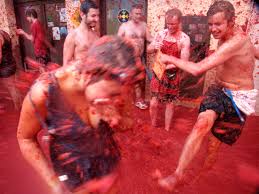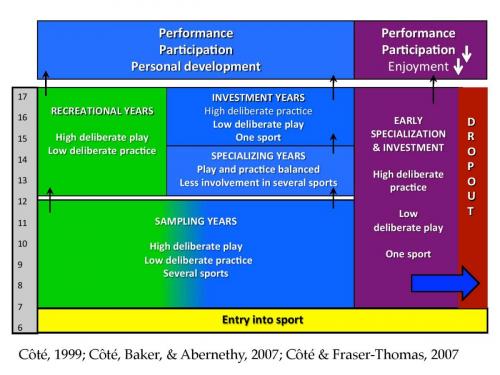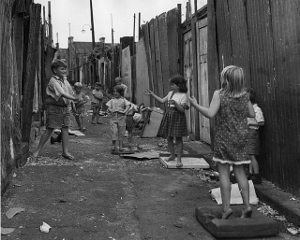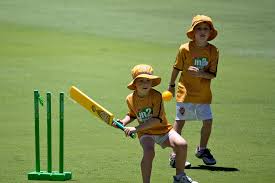The Talent ID Bun Fight
“I feel pressurised as a parent to choose between sports for my daughters”.
 Said a concerned Mum at a recent workshop. She is far from alone. Talent identification has been misused by sports as an excuse for working kids too early and too hard.
Said a concerned Mum at a recent workshop. She is far from alone. Talent identification has been misused by sports as an excuse for working kids too early and too hard.
Well meaning, but concerned, parents are being asked to ferry their children from “selection camp” to “regional centre” to “talent pathway nuclei” (O.K. I made that last one up).
They are often told that if their child fails to attend, then their sporting career is over.... at 14! Is that true?
Research consistently shows that elite sports performers come from a diverse sporting background, and only specialised at around 15-16 years old (1). Most often they are late maturers.
NGBS are trying to select “talent” at 13-14 years old and keep them in their own pathway. They recognise that there is massive competition between sports, this is especially true with female athletes who are good at both Netball and Hockey.
But “talent” really is hard to identify until after puberty and some maturation- about 16 years old. What NGBS are selecting is often “early maturers” or “early birth date” children. This is a temporary advantage that is eliminated when the children get to be 17-19 years old.
Selection is also reliant on “devoted parents“: simply those parents who can survive the Corinthian task of organising the logistics of attending all these sessions.
Examples of the madness
Hockey says that players need to come up through its “Single System“. This requires endless camps and selection days, with selectors looking at who made it on the squad last year, rather than who is the current best player.
This means a desperate rush to get onto the Under-16s squad so that you are “in the system”.
 Anyone on the Under 18s squad is supposed to sign up to the AASE programme which requires extra sessions in Bristol every week.
Anyone on the Under 18s squad is supposed to sign up to the AASE programme which requires extra sessions in Bristol every week.
Is that necessary for kids who are already studying for 3-4 A levels? They hardly need to be part of an apprenticeship.
Netball players in Devon have to choose between training in Bath or Truro (2 hours drive each way) every week if they want to progress.
One 15 year old I coach told Netball South West that she was struggling to get her homework done in GCSE year, she was told “do your homework in the car”.
Another Netballer was told “to move to a school closer to the Talent and Performance Centre in Bath” ! Who are these people? Do they have any touch with reality?
Talent Development Model or Pay per Hour Model?
Cricket players are told to take part in “Winter nets” to stay in the county squad. The fact that year round training of a high impact activity increases the risk of spinal injury like Pars defects seems to be an afterthought.
Tennis is in it’s own mad race to the bottom.
One “Talent ID” session in Exeter was looking at 5 year olds and whether they had a chopper grip serve: 5 years old! Is that talent or a learned activity?
I see some local 13 year olds doing 30 hours of tennis a week! This is hardly necessary at this age: what it does is line the pockets of coaches.
It is a pay per hour model (thanks to Brendan Chaplin for pointing this out to me).
It is recommended that young athletes have 2-3 months off from their sport each year to prevent burnout (1).
They could use this time to play another sport, and allow their bodies to grow, develop and recover from the one sided dominant nature of tennis or cricket or golf.
More importantly, they could play in the park with their mates. Middle class parents especially may be hampering their child’s development through over formalising the process. Kids who spend more than hours a week than their age in organised sports are at greater injury risk (4).
But how would the coach earn money in that case?
Unfortunately, I rarely see a good looking athlete with a tennis racquet or cricket bat. Instead, I see a lot of early specialisers who lack all round physical skills that will help their Long Term Athletic Development (LTAD) (research articles on that link).
Note to Parents
Your child’s health and well being is paramount. All else is secondary to that. Whilst you may be under pressure to make a decision that affects your child’s selection in the next month, be aware that there is no evidence that early specialisation has any benefit.
In fact, early specialisation is fraught with danger: risk of overuse, injury and burnout (3). Remember that the NGBS are trying to capture your child early for their benefit: they need numbers, and they are worried about another sport getting them!
The model shown below shows 3 different strands of Talent development and the potential outcomes (thanks to Professor Jean Côté for sharing).
Here are the key points you may wish to consider:
 Early participation is great, early specialisation less so.
Early participation is great, early specialisation less so.- Your child needs an off season from their sport: every year.
- Motor skill learning is dependent on “trial and error” and “free play“. The body learns better when the brain is free from too much technical instruction. Kick about games in the local park are essential.
- Variety of sport and activity is crucial: water, land, jumping, bat and ball, bike, horse, board, individual, team. Get your child to taste everything: informally at first.
- Competition is great: but led by kids, rather than an adult imposed top down model. Let them win and lose the street “British Bulldog Championships” and come home with scraped knees. Better than the under -12s regional 11 a side “must win” football tournament led by parents..
- Play, play, play: a minimum ratio of 1 hour of play for every hour of organised activity is recommended to reduce injury risk (4).
If your child is being forced to choose: take a deep breath and gain a sense of perspective. Having fun and some down time is important for their development. It is a long term approach.
Further reading
- Training young athletes
- Is my child overtraining?
References
- P. Ford, M. De Ste Croix, R. Lloyd, R. Meyers, M. Moosavi, J. Oliver, K. Till, and C. Williams, “The Long-Term Athlete Development model: Physiological evidence and application”, Journal of Sports Sciences, vol. 29, pp. 389-402, 2011
- Brenner, J. S. (2007). Overuse injuries, overtraining, and burnout in child and adolescent athletes. Pediatrics, 119, 1242-1245.
- Position Statement from the American Medical Society for Sports Medicine (AMSSM,2014).
- American Academy of Pediatrics. “Sports specialization, hours spent in organized sports may predict young athlete injury.” ScienceDaily, 28 October 2013


I like Matt’s comments – lets all get on with some basketball (never going to be a medal contender therefore not funded despite being one of the most popular sports in UK)!!
The Talent ID Bun Fight is in my opinion a direct result of the professionalisation of sport and coupled to the alignment Matt highlights above in terms of success whether medals or other forms of rewards. This is directly linked to how we now measure success….numbers of medals versus participants in sport / each discipline all linked to FUNDING of one form or another. I would advocate Sporting Development Centres across the Counties that would nurture young children well into their teens; such centres would also allow a degree of oversight.
Neil
The “fight” for players between sports is not helped by the obsession of uk sport have for winning medals. If sports had more evenly allocated funding which was not dependent on medals, maybe sports would be under less pressure to force athletes to specialise early.
Increased funding for team sports can have a positive impact on increasing participation for large numbers of the population, as opposed to a large amount of funding for a few individuals considered to have a good medal chance.
Matt
Thanks Neil and Matt. Interesting that one of the NGBs has kicked off about this blog calling me a “business person” and it is “unprofessional”!
A very thought provoking read. Having worked with various levels of young athletes in multiple sports with a small percentage ‘making it’ we have to be concerned at the choices children are being asked to make. Parents are often ill informed of the consequences of the choices that their child may make.
The reality is that very very few sports will create a career path that can fund an adult life. My first issue is with educational choices being made on the back of sporting choices.
My second issue is the injury risk on the developing body, using training means that coaches little understand applying adult training principles to children. It has injury written all other except for the very few.
My third issue is the disengagement of the child and/ or parent from the sport they once loved. Having worked within a school and university setting this is a strong theme that seems to be ignored.
We all have a responsibility to be asking these thought provoking questions however controversial they may be , teachers, coaches, parents, medical professionals and those in all levels of sport.
Thanks for the reply. Great point about disengagement from the sport: their focus changes from love of game to jumping through hoops.
I always try and get them to love the game again, the rest is a bonus.
Interesting how defensive some people have become about this. Vested interests or just removed from reality.
Couldn’t agree more with the england netball pathway
Carl S
Funny, this cropped up last night when I was watching my son play under under 13s cricket and I asked a parent why she let her 10 year old son play in the under 13s cricket squad. I was staggered at her angry answer that it meant he got an extra session a week, so played nearly every day!!! I decided discretion was the better part of valour and let her get on with it!
An interesting piece on the BBC News Today and a discussion on Radio 5. Chris Packham and Bill Oddie observing that lots of kids aren’t allowed to go out and play unsupervised any more and the detrimental effects this was having on kids. Many parents are over protective and forbid kids to even climb trees any more. When criticised for this comment Chris Packham referred to a statistic that more children were killed as a result of accidents in the home than falling out of trees!! Can’t argue with that really.
The most relevant point I see here, which manifests itself within all major school sports, is the lack of diversity amongst young children. Coaches and parents see a child ”make it” at 13 years old and therefore cant play any other sport. What they forget is the lessons, skills and physical attributes that can be learnt and developed through playing a variety of sports, especially at a young age. Many coaches want their athletes to play their sport all year round, but by the time these children turn 16-17 they are broken and disengaged within that chosen sport.
Brett
You would not do this with your diet.Can you imagine eating only apples every day and in vast quantities? Why do this with your recreation and exercise regime? balance is healthy and children should have a balanced lifestyle to ensure healthy physical and emotional development.
Richard
Teacher and coach for 25 years
Hi James
I read with interest, as with all your postings and the web site in general, the interesting thoughts on young athletes. Of course as coaching is now becoming increasingly more a career with opportunities and full time positions the pressure on coaches to produce the goods. I use the word ‘goods’ as sports performers even young ones are commodities and a route to earn a living. Most coaches are child centred but inevitably if it is your lively hood you get judged on results. Even PE staff in schools, educators, are increasingly under pressure to produce results particularly in the private sector.
Returning to amateur sport played for fun and linked to a gentler pathway of development fits. Perhaps the issue is not the coach but facilities and locations. If every school had a S and C coach, a nutritionist, a video analysis expert, a bio- mechanics expert and more PE teachers who place the child at the centre of the pathway some of the negative experiences maybe overcome.
Colin.
Hi James,
I have read all of the comments above and was interested to know what type of model you think works that exists? Or what you think the ideal model would like for a sporty, athletic junior?
Are their existing practical models currently which seem to work?
Thanks,
Richard
Hi Richard,
did you see the diagram from Cote? A broad sampling and participation is best. However, even though sports say they agree with this, in reality they ask the “talented 9 year old” to come along twice a week. That stops them from doing something else, or playing!
All of this is done retrospectively as there are no longitudinal models comparing different systems.
Throw the school chaos into the mix and it is very hard.
Hence why I set up the Athletic Development Centre: to offer that base over time, where the members then play a sport of their choice outside.
I have seen too many broken bodies, minds and spirits over the last 10 years.
Hi James,
Yes I have just looked further into it and read a few journal pieces on motivations of young children as well how coaches can influence participation. Unfortunately I cannot access the document you are referring to above so I have e-mailed Dr Jean Cote to see if I can gain access to the document. Do you have a copy perhaps that I could look at further?
My reading unfortunately and interestingly has only brought about more questions. 1. The research I have read only looks at individual sports 2. The research has been done in Canada I think which will have a totally different set up for developing sport Club Vs School, Winning Vs Skill Development. Do we have any research from the UK worth reading?
I also think that at some point people get to the stage where they drop out of certain activities. If you specialize earlier I think you will drop out earlier. So what’s the best age for our athletes to be specializing, well it’s probably connected to the team and when we think they will peak best in each sport. My instincts say Elite sports want teams to peak together at the same time, perhaps 18-23? Is our body in it’s best state, is our mind in it’s freshest state at this age? Physiologically I am sure you will be able to answer that but psychologically it’s more difficult to answer. We have many influences posed on us, money, education, family influences, motivations.
It’s a fascinating discussion and it’s one that’s critical to our nation with obesity levels rising. What’s your motivation for sports development? Is it long term participation or elite performance or both?
Richard
Hi Richard, if you email me I can send you some relevant journal articles and a great chapter of book.
As much as I dislike early specialisation, I wonder how many of the current top 32 tennis players played competitive rugby/football/netball/swam etc until they were 14?
To the last anonymous comment ( please leave your name): early sampling means playing different sports and many different aspects of deliberate play. That is different from “competitive rugby until 14etc”.
Playing/ participating.
[…] The talent id bun fight […]
[…] The Talent ID bun fight A look at why young people who are good at sport are in danger of injury and burnout. The system in the UK that has National Governing Bodies scrabbling for funding by increasing “participation” leads to a nightmare for parents. […]
[…] The Talent ID Bun Fight […]